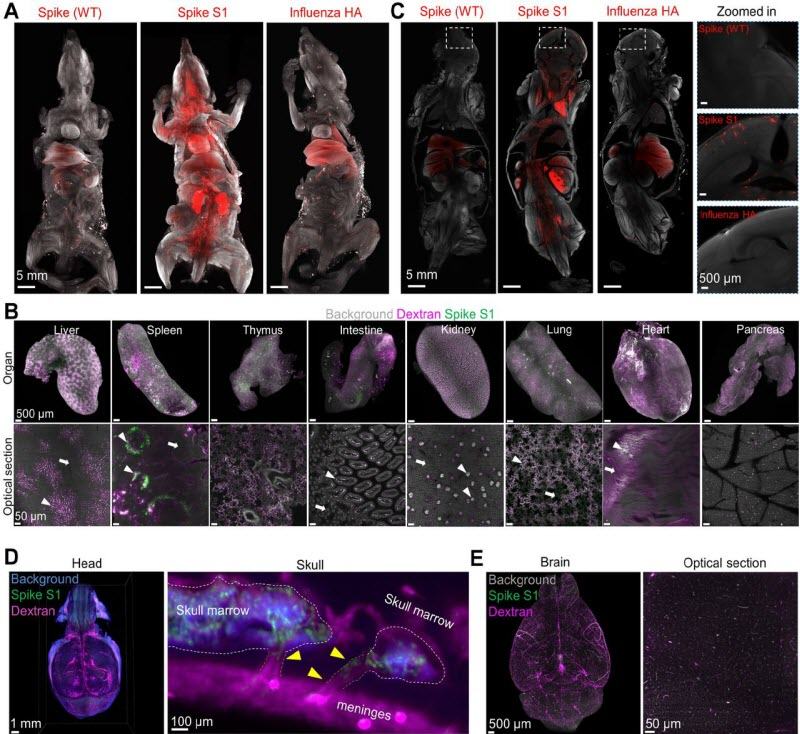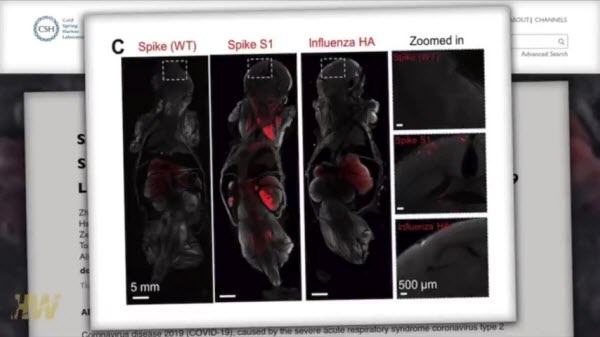New Study on Transparent Mice Finds Injected Spike Protein Travels to Most Organs Within 30 Minutes
“At 30 minutes post-intravenous injection…We detected spike S1 binding in most organs, including the heart, lung, liver, kidney, intestine, thymus, spleen, and pancreas.”
New Study on Transparent Mice Finds Injected Spike Protein Travels to Most Organs Within 30 Minutes
Rough Transcript:
So, recently, over the past several years, I did not know this; I had to look it up, but it is pretty interesting: “scientists make transparent mice to study cellular connections.” So they take the hemoglobin out of these mice so they can study these connections that are happening. They can use dyes and fluorescence dyes in them and see how things really work in the body. I mean, obviously, it’s really, really helpful for science.
Researchers in Germany have utilized this to look at the spike protein and the distribution of the spike protein around the body in a mouse model.
This is a study here that just came out; it’s kind of going all over the internet.
- SARS-CoV-2 Spike Protein Accumulation in the Skull-Meninges-Brain Axis: Potential Implications for Long-Term Neurological Complications in post-COVID-19
- doi: https://doi.org/10.1101/2023.04.04.535604
- https://www.biorxiv.org/content/10.1101/2023.04.04.535604v1.full
- https://www.biorxiv.org/content/10.1101/2023.04.04.535604v1.full.pdf
- April 05, 2023.
- Zhouyi Rong, Hongcheng Mai, Saketh Kapoor, Victor G. Puelles, Jan Czogalla, Julia Schädler, Jessica Vering, Claire Delbridge, Hanno Steinke, Hannah Frenzel, Katja Schmidt, Özüm Sehnaz Caliskan, Jochen Martin Wettengel, Fatma Cherif, Mayar Ali, Zeynep Ilgin Kolabas, Selin Ulukaya, Izabela Horvath, Shan Zhao, Natalie Krahmer, Sabina Tahirovic, Ali Önder Yildirim, Tobias B. Huber, Benjamin Ondruschka, Ingo Bechmann, Gregor Ebert, Ulrike Protzer, Harsharan Singh Bhatia, Farida Hellal, Ali Ertürk
- Supplementary Material
- https://www.biorxiv.org/content/10.1101/2023.04.04.535604v1.supplementary-material
The researchers say “The lack of evidence for the viral presence and especially viral replication in the brain led to the hypothesis that virus-shed proteins circulating the bloodstream may promote an inflammatory response, independent of direct viral infection of the affected organs, including the brain. Notably, the highly immunogenic spike protein also used in COVID-19 vaccines might be a candidate for triggering infection-independent effects.”
So really quickly, what these researchers did was take three mice, these transparent mice, and gave them an IV injection of either a spike protein that was mutated (altered to mimic SARS-CoV-2, in that it seeks to attach to the ACE receptors), or one of two controls: a.) a wild-type spike protein that didn’t have an affinity for those ACE-2 receptors in the cells, or b.) a protein from an influenza virus.
Here’s what the researchers reported after this IV injection:
“At 30 minutes post-intravenous injection, the mice were transcardially perfused, and their whole bodies were subjected to optical transparency clearing and imaged using light-sheet microscopy. We detected spike S1 binding in most organs, including the heart, lung, liver, kidney, intestine, thymus, spleen, and pancreas…“
And Del, here’s the image. This is what it looks like. The middle one, if you guessed it by now, lit up like a Christmas tree is the spike protein, and that is the distribution at 30 minutes after IV injection of this spike protein.
You can see the lighting up of a lot of the organs compared to the wild-type spike protein on the left and the influenza protein on the right, not really rapidly speeding through and transporting through the body and ending up in the organs like the other ones.
Now, if you go to the second image here from that, they bring it to the individual organ, and you can see each one of those organs, and underneath them, there are little arrows, and those are the spike proteins. They’re finding these spike proteins in all of them.
So, before, again, we had lipid nanoparticles, and they were saying, “Well, these are going around the body. So, what’s happening in the spike protein? Are those accumulating in the organs?” We didn’t really know. We had some autopsies where we showed people that had the spike protein in their brain, and there were a lot of hypotheses around that.
So now we’re getting a mouse model with this. It’s not an exact, science-and-not-exact model, but we’re getting some looks at this.
So the research is wrote: “…Spike S1 was also detected in the brain prefrontal cortex. Further examining the mouse heads, we found substantial spike S1 accumulation in the skull marrow niches. Notably, we detected the spike protein in the channels connecting the skull marrow to the meninges…“
We can see a picture of that here. So this is looking down on the mouse, and that little box at the top with the dotted lines is the area that’s magnified to the right, and that’s the head; that’s the brain. And you can see in the middle there, and in that middle picture on the right, the spike S1, there’s a red fluorescent dye highlighted there. You can see it.
It’s not good. This is not good. You do not want to see this.
The researchers write this simply: “…the injection of the spike protein alone caused cell death in the brain, highlighting a direct effect on brain tissue.”
And remember, Del, really, the FDA approved the new bivalent booster based on data from Pfizer & Moderna on mice. Apparently, they didn’t use ‘these’ mice.
Eight mice. I mean, people say, “Well, you’re only looking at three mice in this study.” Yeah, eight mice just determined that the new bivalent booster is safe for everybody. Eight mice. No humans. Eight total mice.
Jeffrey, great reporting. Super interesting. And boy, those visuals are really powerful, and when I’m talking to friends and family members that are starting to have issues, that did get the vaccine out there, or those that we meet on the road, you do get this sense that it’s happening all over the body, and really, it’s like, what organ is going to fail first? Is it going to be cancer before it’s the swelling of the heart? Really problematic. And as I said to Neil deGrasse Tyson last week, this story isn’t over. We are going to find out if more people die from this vaccine than were ever going to die from the virus itself. So, super interesting and sad. Thank you for your great work.
What to do if you’ve taken the jab?
- Clearing Spike Protein by Fasting (it’s the Only Way)
- 1 minute Spike-Protein Antidote (Dandelion)
- Time-Saving & Cheap Health Shortcuts
- If you are Forced to Get the Jab…
- Category: Solutions-Health
- Pfizer switched templates that could cause permanent genome changes to those injected & their offspring…[Senate Hearing]
- Dental anaesthetics graphene/nanotech
- Fauci (2019) Self-Assembling Nano Flu Vaccines
- Game is Over – Microscopy – Contents of Vials [3/6]
- [2a] Game is over: Graphene – Raman Evidence
- BlueTRUTH [Part-1/5] Documentary
- Autopsies: Evidence for Jab-Related Harm & Death. (Prof. Dr. Arne Burkhardt)
- [Prof Nazar] C19 Vaccine-Bioweapon Genocide (paper & presentation)
- Pfizer Employees don’t get the same “fake-vaccine” as the rest of Australia
- Lieberman > Lieber > HCQ > Quantum Dot > Self-Assembling NanoTech > DARPA > Nano-Networks
- C19 Vial Contents Summary (Presentation & Paper comparing 26 Labs from 16 countries)
- Dr Ryan Cole – no graphene or parasites in 100+ vials tested
- George Christensen on Vial Contents
- [Funeral Directors] speaking up about Covid, Boosters & now FLU shots!
- [Download] Analysis Reports (Vials, Bloodwork & Autopsies)
- [Australia] What’s In The ‘Unjabbed’ Blood? (QLD Friend)
- [Israel] What’s In The ‘Unjabbed’ Blood? (Dr Yanowitz)
- † Another Graphene Whistleblower Found Dead
- Magnetic Phenomenon is Real
- [Italy] What’s in the Blood? 1,006 Jabbed Patients [Dark-Field Paper -Pfizer/Moderna]

Site Notifications/Chat:
- Telegram Post Updates @JourneyToABetterLife (channel)
- Telegram Chatroom @JourneyBetterLifeCHAT (say hi / share info)
- Gettr Post Updates @chesaus (like fakebook)
Videos:






![[Dr John B.] What’s In The Vials? (Pfizer Microscopy)](https://pennybutler.com/wp-content/uploads/2022/04/DrJohnB-Pfizer-microscopy-1-777x437.jpg)
![Propaganda Antidotes [Part 14]](https://pennybutler.com/wp-content/uploads/2017/05/morpheus-red-pill-blue-pill-465x437.jpg)
